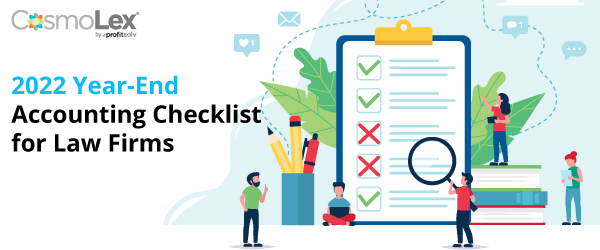End-of-Year Accounting for Law Firms
12.19.2022

Don’t let the looming tax season dampen your joy during the most wonderful time of the year. To enjoy your holiday plans without the specter of outstanding tasks hanging over your head, get proactive about closing out your 2022 books.
Review cash flow
You monitor your cash flow throughout the year, but now is the time to take a closer look.
Review invoices and expenses
Are any clients waiting on December invoices? Send those now. If any bills are due, pay them by December 31st—especially if you hope to expense them in the current year. Plan to check in again on December 31st for any late-month bills or missed invoices.
Reconcile accounts
Make sure your bank transactions and books align and double-check that you’ve logged bank fees and interest. Next, identify any transactions that haven’t cleared in your operating and trust accounts.
Transactions under 30 days old may not have cleared because of their proximity to the statement closing date. Uncleared transactions that are 30 days or older may require some sleuthing. First, confirm whether the entries are correct. If so, contact the relevant party to determine why the transaction hasn’t cleared. (The issue could be as simple as someone forgetting to deposit a check.)
Address uncleared transactions
If transactions in your trust account haven’t cleared for an extended period, check with your local bar association to determine how to dispose of those assets. If your operating account contains uncleared transactions for an extended duration, you may need to reissue or void them.
Once you’ve done your due diligence to reconcile your accounts, review them with your accounting professional and make adjustments as needed.
Credit card statements
Have your credit card accounts incurred finance charges, cash rewards, interest c, or late fees? If so, log them. Next, confirm that you’ve linked all client costs charged to your credit cards to the correct client and matter.
Finally, compare your credit card statement transactions to your books. Does everything align as you’d expect?
Review trust accounts
Confirm your current retainer balances.
Your retainer balances should be high enough to cover the remaining activity through the end of the year and well into Q1 of 2023. If they’re not, identify which retainers need replenishment, and invoice the appropriate clients immediately. Issue refunds for any closed matters with a lingering retainer balance.
Identify current balances for client trust activities, checking that they’re posted. Run a three-way bank reconciliation to make sure that the adjusted bank balance, book balance, and client trust ledger balance are in alignment.
Print and archive these reports for your records and send annual trust ledger reports to your clients, if your local bar rules require it.
End-of-year reports
End-of-year reports identify irregularities in your balance sheet, so you can straighten them out before December 31st.
Liabilities
Add any new liabilities your firm has incurred to your balance sheet. For both long-term and short-term liabilities:
- Review opening date and terms
- Check that payments reflect debt service
- Determine whether the principal has been reduced (Exception: interest-only debt)
Assets
If your firm incurred any new assets during the year, congratulations. Add those to the balance sheet, too.
Note: Consult with your accountant to make sure you post any accrued depreciation according to the IRS schedules.
For advanced client costs, review all relevant transactions for accuracy. Check for unrecoverable expenses, working with your accountant to determine whether you should write off those expenses as bad debt.
Equity
Owner contributions
Identify any owner-initiated or capital contributions to equity. Ensure that appropriate non-business owner expenses are allocated correctly.
Owner’s draw
Personal expenses are sometimes charged to business credit cards throughout the year. Account for any such transactions now.
Whether or not income to the firm’s owner is allocated under salary expenses is dependent on your business designation. If it’s not appropriate to allocate this cost under salary expense, be sure all draws are included.
Review profit and loss
Developing a profit and loss statement can feel labyrinthine at first, but the process is straightforward when you break it into chunks.
Income Accounts
Review your income accounts to confirm allocated transactions, total your fee income, and review reimbursed client costs. Account for any existing discounts, which reduce your fee income.
Expense Accounts
First things first: make sure the data you’re viewing is accurate. If duplicate expense accounts have been created by mistake, merge them and ensure that sub-accounts are properly listed.
From there, review reimbursable client costs expenses to ensure they’re properly posted. Write off any unrecoverable expenses now.
Note: Don’t worry if this expense and its counterpart aren’t equal. It’s unlikely that they will be.
Finally, double-check that all client reimbursements are posted to the proper accounts.
Accounts receivable and Collections
Review your overall accounts receivable aging report on December 31st. Look for invoices that are over 60 days old. Send a Dunning letter or other notification to those clients, and create a plan with your accountant to write off any unrecoverable invoices.
Retainer balances (as of December 31)
Review your retainer balances one final time. Are there open invoices? If so, pay those from the appropriate client’s trust. For any matters that have become inactive since your last review, issue refunds.
Non-employee compensation
Did your firm rely on expert witnesses, independent contractors, or non-employee attorneys during the year? Any non-employee or vendor who received compensation over $600 throughout the year will need a 1099 form.
Obtain EINs or Social Security numbers to prepare a Form 1099-Misc for each person. Then, file a Form 1096 compilation.
Touch base with your accountant
With the help of your accountant, run a trial balance report and make adjustments as instructed. Be sure to close your books effective December 31 to avoid any accidental edits or changes.
Wrapping up
As the year comes to a close, reflect back and determine what went well, whether any errors were made, and how you can set yourself up to enjoy success in 2023.
Congratulations on another year in the books!





